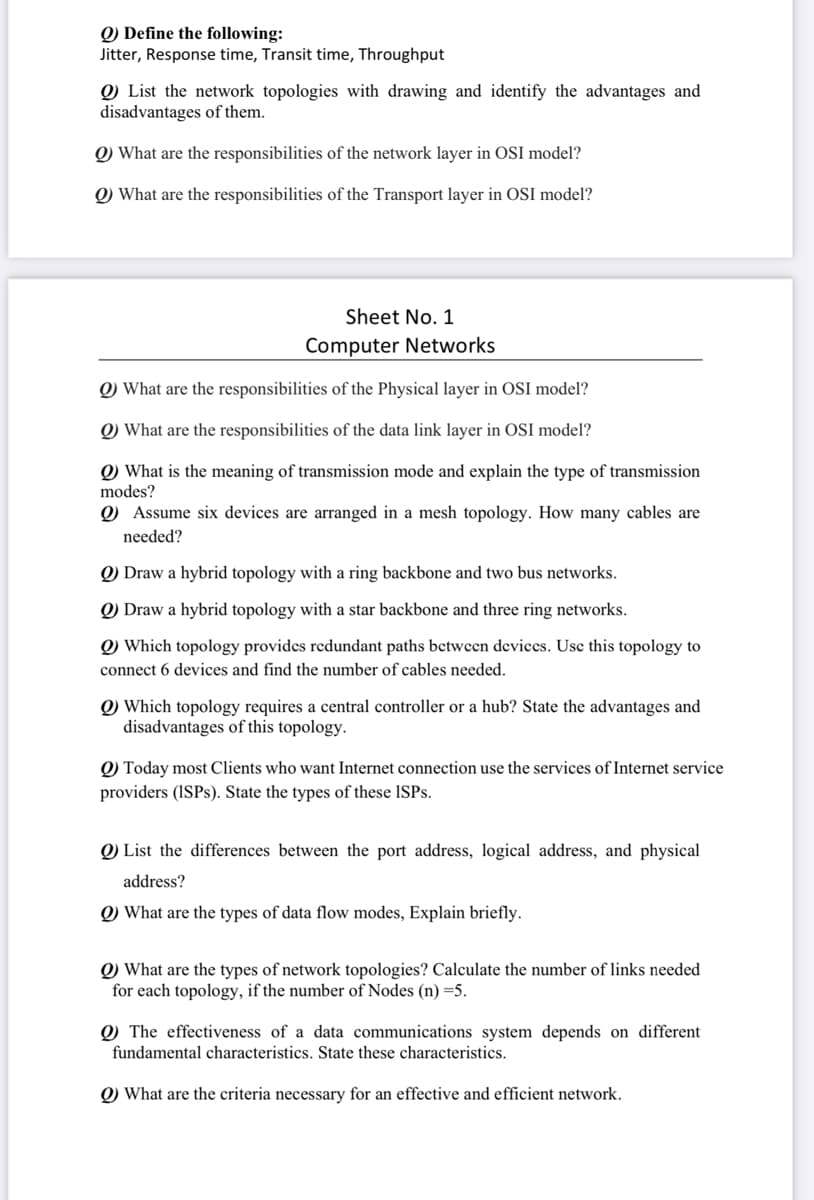O Define the following: Jitter, Response time, Transit time, Throughput List the network topologies with drawing and identify the advantages and disadvantages of them. Q What are the responsibilities of the network layer in OSI model? Q) What are the responsibilities of the Transport layer in OSI model?
O Define the following: Jitter, Response time, Transit time, Throughput List the network topologies with drawing and identify the advantages and disadvantages of them. Q What are the responsibilities of the network layer in OSI model? Q) What are the responsibilities of the Transport layer in OSI model?
Computer Networking: A Top-Down Approach (7th Edition)
7th Edition
ISBN:9780133594140
Author:James Kurose, Keith Ross
Publisher:James Kurose, Keith Ross
Chapter1: Computer Networks And The Internet
Section: Chapter Questions
Problem R1RQ: What is the difference between a host and an end system? List several different types of end...
Related questions
Question

Transcribed Image Text:O) Define the following:
Jitter, Response time, Transit time, Throughput
List the network topologies with drawing and identify the advantages and
disadvantages of them.
Q What are the responsibilities of the network layer in OSI model?
Q) What are the responsibilities of the Transport layer in OSI model?
Sheet No. 1
Computer Networks
Q) What are the responsibilities of the Physical layer in OSI model?
O) What are the responsibilities of the data link layer in OSI model?
Q What is the meaning of transmission mode and explain the type of transmission
modes?
QAssume six devices are arranged in a mesh topology. How many cables are
needed?
Q) Draw a hybrid topology with a ring backbone and two bus networks.
Q) Draw a hybrid topology with a star backbone and three ring networks.
Which topology provides redundant paths between devices. Use this topology to
connect 6 devices and find the number of cables needed.
Which topology requires a central controller or a hub? State the advantages and
disadvantages of this topology.
Q) Today most Clients who want Internet connection use the services of Internet service
providers (ISPs). State the types of these ISPs.
O List the differences between the port address, logical address, and physical
address?
What are the types of data flow modes, Explain briefly.
Q What are the types of network topologies? Calculate the number of links needed
for each topology, if the number of Nodes (n) =5.
The effectiveness of a data communications system depends on different
fundamental characteristics. State these characteristics.
Q What are the criteria necessary for an effective and efficient network.
Expert Solution
This question has been solved!
Explore an expertly crafted, step-by-step solution for a thorough understanding of key concepts.
Step by step
Solved in 3 steps

Recommended textbooks for you

Computer Networking: A Top-Down Approach (7th Edi…
Computer Engineering
ISBN:
9780133594140
Author:
James Kurose, Keith Ross
Publisher:
PEARSON

Computer Organization and Design MIPS Edition, Fi…
Computer Engineering
ISBN:
9780124077263
Author:
David A. Patterson, John L. Hennessy
Publisher:
Elsevier Science

Network+ Guide to Networks (MindTap Course List)
Computer Engineering
ISBN:
9781337569330
Author:
Jill West, Tamara Dean, Jean Andrews
Publisher:
Cengage Learning

Computer Networking: A Top-Down Approach (7th Edi…
Computer Engineering
ISBN:
9780133594140
Author:
James Kurose, Keith Ross
Publisher:
PEARSON

Computer Organization and Design MIPS Edition, Fi…
Computer Engineering
ISBN:
9780124077263
Author:
David A. Patterson, John L. Hennessy
Publisher:
Elsevier Science

Network+ Guide to Networks (MindTap Course List)
Computer Engineering
ISBN:
9781337569330
Author:
Jill West, Tamara Dean, Jean Andrews
Publisher:
Cengage Learning

Concepts of Database Management
Computer Engineering
ISBN:
9781337093422
Author:
Joy L. Starks, Philip J. Pratt, Mary Z. Last
Publisher:
Cengage Learning

Prelude to Programming
Computer Engineering
ISBN:
9780133750423
Author:
VENIT, Stewart
Publisher:
Pearson Education

Sc Business Data Communications and Networking, T…
Computer Engineering
ISBN:
9781119368830
Author:
FITZGERALD
Publisher:
WILEY